#Adi-buddha
Text
Illusion, fear and wrong thinking? A good question
Greetings to you, visitors to the cave
Let me begin this post by asking you a question. No. I’ll start again: I’m going to begin this post by asking me a question. It’s a question prompted by prayers I recite every day, not only during my morning practice, but at random times during the day. Here goes with the question:
How much time do I spend discussing illusion, fear, and wrong…
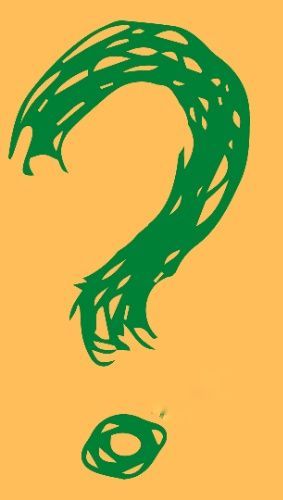
View On WordPress
#&039;spiritual practice#Adi Shankara#aspirations#authenticiy#be here#be here and now#be now#blogging spirituality#Buddha#change the world#contemplative life#Contemplative Living#creativity#decision making#devotion#dharma#faith#fantasy#food for thought#George Harrison#here and now#hermit#hermitage#human beings#in the moment#inspiration#inspirational#intention#Just for today#language
0 notes
Text

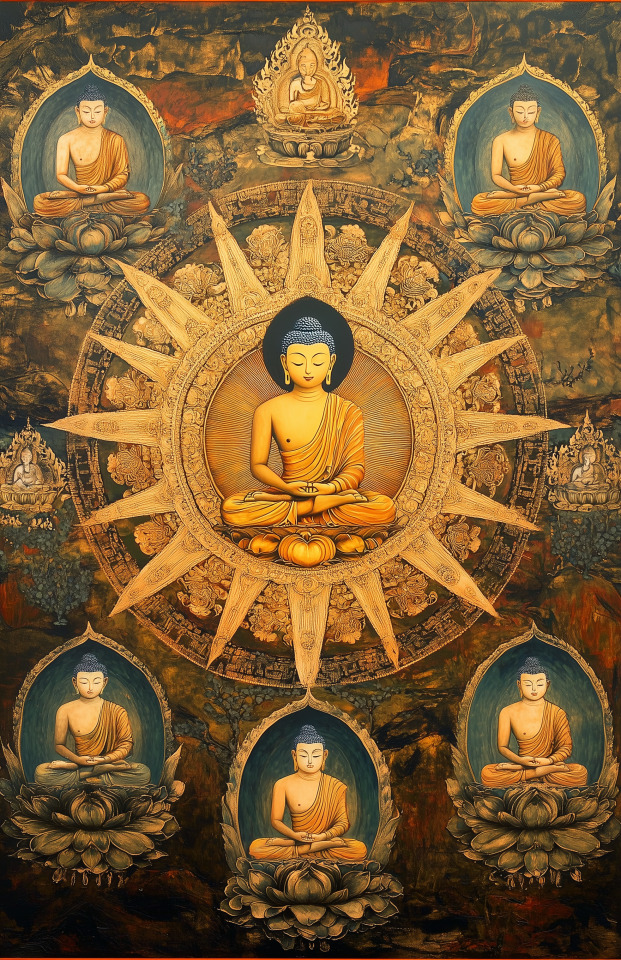
Vairocana | The Five Wisdom Buddhas
Talon Abraxas
Not all Buddhas were considered flesh and blood or walked the earth. The Five Wisdom Buddhas are the Wisdom states as persons. The body of Vairocana is the body of the True Dharma.
The Five Wisdom Buddhas arose during the Mahayana development in India and were taken up by Tantric Buddhism. In Japan they appear in Shingon. These Buddhas differ from the Buddhas who appear in the lineage or who are said to have walked the earth at a certain time in a certain place as they represent principles of Mahayana teaching. They are sometimes called ‘Meditation Buddhas’ to distinguish them and because they may only be encountered in the states of meditation that form their bodies.
Vairocana is called the ‘Sun Buddha’ and is the ‘First’ (Skt. Adi) or ‘Primoridial’ Buddha and sits in the central place of the Five Wisdom Buddhas mandala surrounded by the four other Wisdom Buddhas who sit at the cardinal points. His name in Japanese is Dainichi Nyorai – The Buddha of Universal Illumination. His names and attributes are all connected with light and illumination, rays of life-giving power that initiate, nourish and sustain as the sun does all life on earth.
In Mahayana teaching his body is the Body of the Dharma (Skt. Dharmakaya), and is synonymous with such terms in Zen as ‘True Nature’, ‘True Face’ and ‘Buddha-nature’. His nature is emptiness (Skt. Sunyata), the ‘unborn’ of which the Buddha spoke in the Pali Canon, without which that which is born and created could not come into being.
Vairocana first appeared in the Brahmajala Sutra, a 5th Century manuscript written in Sanskrit and translated into Chinese by Kumarajiva. The title translates into English as Brahma’s Net Sutra. This relates to the analogy used by the Buddha who described a net that spreads throughout the universe in the three dimensions of space: length, breadth and depth. Where three strands meet there is a jewel to hold them in place like a dewy spider’s web. Each jewel reflects both itself and all the other jewels in the net simultaneously. The feel of this image is used to point towards the reality of emptiness, the true nature of the Dharmakaya – which is the body of Vairocana.
“Now, I, Vairocana Buddha, am sitting atop a lotus pedestal; on a thousand flowers surrounding me are a thousand Sakyamuni Buddhas. Each flower supports a hundred million worlds; in each world a Sakyamuni Buddha appears. All are seated beneath a Bodhi-tree, all simultaneously attain Buddhahood. All these innumerable Buddhas have Vairocana as their original body. “
-The Brahma’s Net Sutra
As the primordial principle Vairocana speaks outside the phenomenal world where all time is simultaneous. Although in the phenomenal world he has this or that name and is portrayed using this or that hand position (mudra), wearing certain garments and headdress, in truth he is beyond conceptual imagination and yet is ever present in each form, as Master Hakuin wrote: ‘‘like salt in seawater or glue in paint.”
In Shingon Buddhism he is represented by the Sanskrit letter ‘A’ which expresses life & death; emergence & return.
The mantra associated with Vairocana is:
Om a-vi-ra-hûm-kham vajradh��tu vam (Skt.)
Om All Pervading One; Imperishable One
72 notes
·
View notes
Text
GOJO'S DEEP CONNECTION TO BUDDHISM

SIX ELEMENTS
to first understand gojo's deep connection to buddhism, it's important to talk about esoteric buddhism and the six elements. very similar to china's five elements esoteric buddhism has the five elements as: earth, water, fire, air/wind, space/void. however, esoteric buddhism as one additional element the mind. gojo's powers involve space ( his manipulation of space itself and his domain expansion being called unlimited void ). gojo's journey to becoming the strongest was not complete until he opened his mind. as stated, by adding the sixth element the mind, it creates a unity between all five elements. if one lacks the sixth element, ordinary eyes see only the differientated forms/appearances.
this ties in with the fact that gojo's eyes allow him to see things most people cannot see ( people's souls in colors, reading the flow of cursed energy, viewing of his opponent's cursed technique, object dection with or without cursed energy, & being able to see kilometers away ). it can also be said that being born as the six eyes user brought balance, a connection to how the mind element creates unity.
SATORI
in zen buddhism, this is the term for awakening in japanese zen buddhism. it means comprehension, understanding. the word is derived from the japanese verb satoru, who's first name is satoru? gojo's. to put it further, satori refers to an awakening or apprehension of the true nature of reality. it's used to describe an experience that can't be expressed via words. gojo goes through his enlightenment, his death, and never does he really talk about what he went through. he talks about an indescribable feeling, feelng the whole world, this connection to it and to feel everything happening, but if anyone were to ask him how he felt touching the core of cursed energy he would not be able to explain it properly. it is an experience he will never fully properly explain.
another way this ties into gojo is that his confrontation with toji, is something of an antagonistic one. in the way, that after the second fight he truly dislikes having a lack of control, he doesn't want to feel hepless, or be helpless with all the immense power that he has. gojo is forced to face the reality of defeat, the reality of having little control at all, and the fact that he didn't fully realize the capabilities of his powers. in the modern era of jujutsu, gojo is the standard.
ALLUSIONS TO OTHER FIGURES IN BUDDHISM
VAIROCANA
part of the five great buddhas or the five tathāgatas, they are seen as the five representations of the adi-buddha ( aka the first buddha). vairocana is associated with the color white ( gojo's hair is white ), vairocana represents the element of space, which coincides with gojo's technique and ability manipulate space itself. the cardinal direction vairocana represents is the center and the season they represent is a transition. gojo could be considered a big transition in the way the jujutsu world operated as, again his birth balanced out the jujutsu world. it is also a big transition in being dubbed the strongest sorcerer of his era.
MARICI
a goddess associated with the light and sun. alternatively, in japan she is also associated with light or mirage and was invoked to escape enemies. she has several depictions and in some she carries the lotus with her. in gojo's dream/death sequence, there is a drawing of a lotus flower. the lotus flower in buddhism represents purity, spiritual awakening, and faiththfulness. it also symbolizes rebirth ( which will be furthered tied down to another section ) and the implications of nanami and gojo's conversation hints at a rebirth of some sort.
THE SIGNIFICANCE OF THE FOUR DIRECTIONS
in buddhism, there is great importance in north, east, south, and west. for this particular post i will be focusing on the two directions of north and south.
"I ONCE ASKED MEI-SAN ABOUT WHERE I SHOULD LIVE. SHE SAID IF YOU'D LIKE TO BECOME SOMEONE NEW. GO NORTH."
the north is considered a symbol of stability, a fixed goal that never wavers. it also represents unshakeable conviction. when your will is strong, you are under the protection of the guide of the north. when you become unstable, the grace of god pulls you in the right direction. it should be noted that gojo does say i see, gives a wave. in my opinion, it implicates that gojo has determined to go north. gojo is also the type of person who has a strong conviction, his will to ensure that the future of jujutsu sorcery can be on his level, to be strong enough to compete with himself, so that they never have to endure what he/geto went through. gojo is someone who will always aim higher to break the ceiling even if he is the ceiling.
alternatively, there is another direction that is mentioned in said chapter:
"IF YOU'D LIKE TO RETURN TO WHO YOU WERE, GO SOUTH."
the south is associated with death. it offers complete rest. when the body can no longer lead us down our path, the protector of the south, yama raja, lord of death, ensures we get rid of our vehicle ( the body ) and gives us a new one. the catch is that in general, we form attachments to our body, mind, and senses and we have a hard time of letting go. however, once someone does they will find that 'long sleep' is a restful. this line goes in hand with nanami who doesn't hesitate to go south, stuck in the past since he still had attachments to haibara, and in a sense yuji. but at the end of it he was able to let go.
#✧ → ᴡʜᴀᴛ ᴅᴏ ᴛʜᴏsᴇ ᴇʏᴇs sᴇᴇ ᴛʜʀᴏᴜɢʜ? ( ʜᴄ. )#✧ → ᴅɪᴅ ʏᴏᴜ ʀᴇᴀᴄʜ ᴇɴʟɪɢʜᴛᴇɴᴍᴇɴᴛ ? ( sᴛᴜᴅʏ. )#q.#yes the second half is me coping#but i truly believe there's a lot of set up for this#also gojo being paired up with the lotus flower#all very very telling#it's been a lot of research#cross referencing a lot of stuff#you can also make the case that gojo is bodhisattva#hmm maybe i'll cook that
15 notes
·
View notes
Text

A state of NO DESIRE looks like this. It isn't a dystopian dream. It is the truth of one. One is already that. Thou art that. Tat Twam Asi. It is one where there is no seeking. All seeking comes to an end.
How do we know what it's like being without desire?
It is when one is in Union. This is the union everyone is running after. This has nothing to do with religion, spirituality or any other such labels.
Ego feels separate. Separation is a perceived threat to the ego. Ego fears death because it feels it is separate and hence it's existence depends upon guarding the identity of the separate self. All of this is love ofcourse. Ignorant? Yes, but still love, behind the workings of it all.
So then what does the soul long for?
The soul longs for a state where it can stop longing. Where the ego is put to rest, and the illusion is pierced. It occurs very briefly each time a desire is fulfilled. An orgasm is achieved. A thoughtless, delightful sigh of relief- Ah 😌 How blissful. If only this could be the default state forever. That would be Samadhi. The Kundalini mother energy rising from the root wants to meet the Father as he descends from the Crown. That is the internal physical union. A pineal gland fully activated that is producing substance in the brain that sustains the feeling of oneness and universal love continuously.
Should it be artificially, egotistically invoked and meddled with? Ofcourse not. It could short circuit. But this is just one part of the process. This went all over the place. Although it's all the same place.
Tap into it.
Practice.
Override thought attacks.
Practice.
Art "Adi Buddha"
By Kay Konrad
12 notes
·
View notes
Text

Samantbhadra Buddha
His name Samantabhadra in Sanskrit or Kuntuzangpo in Tibetan, means ‘always good', ‘always well’ or ‘unchanging goodness.’ The significance is that unchanging or fundamental goodness is our ultimate nature.
He is pictured in the Yab-Yum (mother-father) sacred embrace with his consort
He is the light blue color of the sky representing the pure state of the mind which is vast and empty, while still including all of existence. She is white, representing pure mental clarity. Together they symbolize the divine union of compassion with wisdom.
He is considered a primordial Adi-Buddha, or "first seed of Buddhahood" representing the Dharmakaya (truth body of enlightenment) according to the Nyingma Tradition of Tibetan Buddhism
“Samantabhadra is not subject to limits of time, place, or physical conditions. Samantabhadra is not a colored being with two eyes, etc. Samantabhadra is the unity of awareness and emptiness, the unity of appearances and emptiness, the nature of mind, natural clarity with unceasing compassion - that is Samantabhadra from the very beginning”
40 notes
·
View notes
Text
Chapter 1085


Yes, that’s the sovereign of the world, whose mere presence fills others with awe and solemn dread. Im is impressive. This is the type of impression Trebol wanted Doflamingo to create when he forced him to be king.


And he also can confirm this impression.
It’s now fully confirmed that Im is connected with the Buddha. Not only is his name, イム, made up of the radicals used in the kanji 仏, Buddha, but also Mu (negative) is an important concept in Buddhism.
Seems like the Five Elders represent the five aggregates of clinging, matter, sensations, perception, formations, and consciousness, the elements making up the physical and mental existence of each person. The symbol of the World Government itself denotes everything that exists in the material world, and has five points.
In Mahayana and Vajrayana Buddhism, the lords of the Five Buddha Families, Vairochana, Akshobhya, Ratnasambhava, Amitabha, and Amoghasiddhi, are associated, among other things, with the five aggregates of clinging. They are sometimes seen as emanations and representations of the five qualities of the Adi-Buddha or "first Buddha", the highest anima mundi.
13 notes
·
View notes
Text

When Lord Buddha said that the Sad-dharma he taught is eternal, it seems that he had two ideas: a) The ultimate truth of a living world (i.e.
Pratityasamutpada) is always continuous from eternity, while the laws of mind are eternally universal. (Just as malice does not die by malice towards others, only friendship dies). b) In various suttas, it has been mentioned that the teaching he taught was the same teaching taught by previous Buddhas and that such Buddhas are extremely numerous.
We know from various sources that when he was a bodhisattva, he met and learned from millions of old Buddhas like Dipankara. In Mahayana Buddha Samantabhadra is presented as the concept of Adi Buddha. Since the world has no beginning and no end, it is a symbolic concept that also refers to the mind nature of each sattva, while also implying the infinite series of Buddhas. Therefore, there is no justification in Buddhism for questions such as what religion did Buddha's father practice, Buddhism existed only for 2500 years, and what was before that. Also, Buddhist scriptures are authentic sources. Buddhism is clear on these questions. They were not Vedic-Hindu and almost all Shakyas died as Buddhists.
2 notes
·
View notes
Text


Send from Sansgreet Android App. Sanskrit greetings app from team @livesanskrit .
It's the first Android app for sending @sanskrit greetings. Download app from https://livesanskrit.com/sansgreet
Guru Purnima
Guru Purnima day to worship your teachers and mentors, will be observed on Saturday, July 24. Teachers are our guiding angel. They guide us on the right path and therefore it becomes important for us to thank them for their selfless service. Guru Purnima or Guru Poornima is the day that holds special importance in the lives of Hindus, Buddhists, and Jains. Celebrated on the full moon day during Ashadha month.
On this day, people worship their spiritual preceptors or gurus. They bring them gifts, visit temples and offer them respect to seek their blessings. Many even observe keep fast to show their respect to their Guru while praying for his long life. On this day, Hindu scriptures say, Lord Shiva, the first or Adi Guru of the world, gave the knowledge of Yoga to Saptarishis (the Seven Sages) for the benefit of humanity. Hence, some people observe fast in honour of their guru and seek their blessings.
#sansgreet #sanskritgreetings #greetingsinsanskrit #sanskritquotes #sanskritthoughts #emergingsanskrit #sanskrittrends #trendsinsanskrit #livesanskrit #sanskritlanguage #sanskritlove #sanskritdailyquotes #sanskritdailythoughts #sanskrit #resanskrit #gurupoornima #vyasapoornima #guru #teacher #mentor #gurupurnima #celebratingsanskrit #vedvyasa #vyasapurnima #buddha #sarnath #gurupadam #indianculture #indiantredition #incredibleindia
#greetingsinsanskrit#sanskritgreetings#sanskrittrends#trendsinsanskrit#livesanskrit#sanskrit#celebratingsanskrit#incredibleindia#kerala
0 notes
Text
Are Varanasi And Banaras Same?
Are Varanasi and Banaras same?
Varanasi also known as Benaras or Banaras or Kashi is the city located in the bank of the sacred river Ganga in the state of Uttar Pradesh in North India which is one of the oldest city in world which existed since 11th century BC. In the past it was also referred to as the spiritual capital of India. However, it is India’s largest religious city, one of the seven sacred cities of Hindus and Jains. It has Hindu people who come to wash their bodies in water from river GANGES and bury their dead. Approximately two thousand temples are located in this city constructed in meandering alleys one of the most significant being the Kashi Vishwanath or the ‘Golden Temple’ that enshrine the lord Shiva.
Varanasi also developed is an industrial city for Muslim and silk fabrics, fragrances, ivory works, art Buddha is said to have come to Kashi and founded Buddhism in 528 BCE in Sarnath where he gave his first sermon known as ‘The Turning of the Wheel of Dharma’. In terms of religion, it is noteworthy that in the VIII century Adi Shankara established Shiva as an official religion of the city. Muslim domination prevailed during the early period of the Middle Ages play an important role in Hinduism as it was a temple and a center of pilgrimage and educational and cultural center of mysticism and poetry. I would also like to mention that Varanasi is the place where Tulsidas, the great Indian poet, composed Ram Charit Manas – the great Indian epic describing the life and deeds of Rama.
0 notes
Link
🌟 Explore the ancient wisdom of Adi Buddha in our latest article! Discover how this profound Tibetan Buddhist concept can transform your life through compassion, mindfulness, and peace. Learn practical steps towards achieving an enlightened mind and enrich your spiritual journey. Dive deep into the essence of Adi Buddha and embrace a life of interconnectedness and enlightenment. Read our insights and share your experiences. Let's grow together in spiritual wisdom! 🌿✨ #SpiritualJourney #AdiBuddha #Mindfulness #Enlightenment
0 notes
Text
"The Attractive Ape." Introduction to the Vajrasuchika Upanishad. The Exploration of the Mysteries of the Diamond Pointed Needle.

The Vajrasuchi Upanishad (Sanskrit: वज्रसूची उपनिषत्, IAST: Vajrasūcī Upaniṣad) is an important Sanskrit text and an Upanishad of Hinduism. It is classified as one of the Samanya (general) Upanishads, and identified as a Vedanta text.[3][2] It is attached to the Samaveda.[3]
The text discusses the four varnas also called 'caste'. It is notable for being a systematic philosophical work against the division of human beings, and for asserting that any human being can achieve the highest spiritual state of existence.
The date as well as the author of Vajrasūchi Upanishad is unclear. The Upanishad is attributed to Sankaracharya in the manuscripts discovered by early 1800s.[1][5] Sankaracharya, also known as Adi Shankara, was an Advaita Vedanta scholar, but given the Indian tradition of dedicating and attributing texts to revered historical scholars, there is uncertainty whether texts attributed to Adi Shankara were actually composed by him or in the 8th-century he likely lived in.
It is numbered 76 of 108.
The Vajrasuchi Upanishad (Sanskrit: वज्रसूची उपनिषत्, IAST: Vajrasūcī Upaniṣad) is an important Sanskrit text and an Upanishad of Hinduism. It is classified as one of the Samanya (general) Upanishads, and identified as a Vedanta text.[3][2] It is attached to the Samaveda.[3]
The text discusses the four varnas also called 'caste'. It is notable for being a systematic philosophical work against the division of human beings, and for asserting that any human being can achieve the highest spiritual state of existence.
The date as well as the author of Vajrasūchi Upanishad is unclear. The Upanishad is attributed to Sankaracharya in the manuscripts discovered by early 1800s.[1][5] Sankaracharya, also known as Adi Shankara, was an Advaita Vedanta scholar, but given the Indian tradition of dedicating and attributing texts to revered historical scholars, there is uncertainty whether texts attributed to Adi Shankara were actually composed by him or in the 8th-century he likely lived in.
It is numbered 76 of 108.
I Shall set for Vajrasuchi (the diamond needle) which pierces ignorance, rebukes the ignorant and ornaments those who have wisdom as eye.
The Smritis affirm, following the Vedas that the Brahmana (seeker of wisdom) is the most important of the four castes. It must be asked, ‘Who is a Brahmana’ – the self, body, class, knowledge, action or virtue ?
The soul is not a Brahmana because the soul is the same in all bodies past and future. The same person takes many bodies according to karma, nor is the body Brahmana – the body is the same from the Chandala (to the highest caste) being made of the five elements and is seen to have old age, death etc., alike.
There is no fixity (of colour) such as Brahmana is white, Kshatriya (soldier) is red, Vaishya (merchant) is yellow and Sudra (servant) is black; also when the father’s body is cremated, the son etc., may be guilty of killing a Brahmana.
Nor is the class a Brahmana. Then there would be many classes within the classes. Many are the great sages: Rishyasringa (does not suffer wrong) born of a deer, Kausika (fragrant resin, virtuous, loving,) of reed, Jambuka of a jackal (a seedless grape, low born), Valmiki of an ant-hill, Vyasa (the severer) of a fisher-girl, Gautama (the first one, the Buddha) of a hare’s back, Vasistha of Urvasi (blood of thigh bone), Agastya (mover of mountains) of a pot according to tradition.
These are not Brahmanas by birth but by their knowledge. Nor is knowledge Brahmana: Kshatriyas and others also have knowledge. Nor is karma: all creatures are seen to have similar karma of Prarabdha (the enterprises of nature) etc., and all creatures act being impelled by karma. Nor is a man of virtue: There are many givers of gold – Kshatriyas etc.
Shankaracharya, said to be an incarnation of Shiva was one of history’s first civil rights pioneers. He was outspoken about ending the caste system, and here he says anyone can realize the Self. He essentially says reincarnation is nonsense. How a man lives and learns determines if his life can attain to the values of the Supreme Being and contribute to society.
This made him very unpopular, so he preached in the wilderness away from his critics. He is the greatest of all Hindu sages. He translated the Bhagavad Gita, is the author of Vivekachoodamani, Atma Bodha and commented on many of the Upanishads. He is said to be the author of the Great Hindu Renaissance. His writing is studied all over the world.
The above script states the mind changes colors as it changes its identity, but certainly that does not change the body or the composition of reality. Changing the mind so it tunes into reality is the goal. To project the willy nillies of the mind onto the body or the world is the antithesis of the discovery of the Self. It denies the role of God in the making of the creation. Nothing we say, think, do, read, write, or feel is ever as Great as all that God can do.
He who preaches from the pulpit on Sunday, “How great Thou Art!” is correct. All else falls short of attempting to explain the splendor of God and how we can be a part of His Plan. One must never use the Name of God or the scriptures to defame God or dim the awe we should all feel in regards to all that He does.
Shankara identifies five “castes” within us that contribute to the Glory of God. They are body, class, knowledge, action and virtue. These we inherit from our parent, the one who teaches us about the Self, the Holy Spirit that is the same in all of us but sheds His Light through our individual thoughts and behaviors.
This parent is called a Smriti by the Upanishads. A Smriti is “the whole body of sacred tradition that is remembered by humanity.” During his life, Shankara combatted a Smriti that suggested the taking of slaves, mistreatment of women, corruption in society were decent ways of life. It was believed persons could be born into a body that was especially blessed or cursed by God and the gods and there was no way to change it except to die and try again. Shankara refutes stating all creatures have an enterprise of their own and this is the “gold” each being mines by being a Khsatriya, a “soldier of the scriptures.”
This is also found in the mantra above, composed by stringing the strange Sanskrit words together, “He who refuses what is wrong, is like a reed of fragrant resin and virtuous tactics, severs what is low born from the ant hill of the mind, achieves manhood, becomes enlightened, and finds God.”
Otherwise, much as Judaism says, man is just an attractive ape with a penchant for nonsense, death, violence, and trouble.
0 notes
Text


“The whole universe is you; the universe is your body; you are the universe both formed and unformed. You are the soul of the universe and its body also. You are God, you are the angels, you are man, you are animals, you are the plants, you are the minerals, you are everything; the manifestation of everything is you. Whatever exists is you. You are the Infinite.”
— Swami Vivekananda
Vairocana ‘Sun Buddha’
Talon Abraxas
Vairocana is called the ‘Sun Buddha’ and is the ‘First’ (Skt. Adi) or ‘Primoridial’ Buddha and sits in the central place of the Five Wisdom Buddhas mandala surrounded by the four other Wisdom Buddhas who sit at the cardinal points. His name in Japanese is Dainichi Nyorai – The Buddha of Universal Illumination. His names and attributes are all connected with light and illumination, rays of life-giving power that initiate, nourish and sustain as the sun does all life on earth.
35 notes
·
View notes
Text
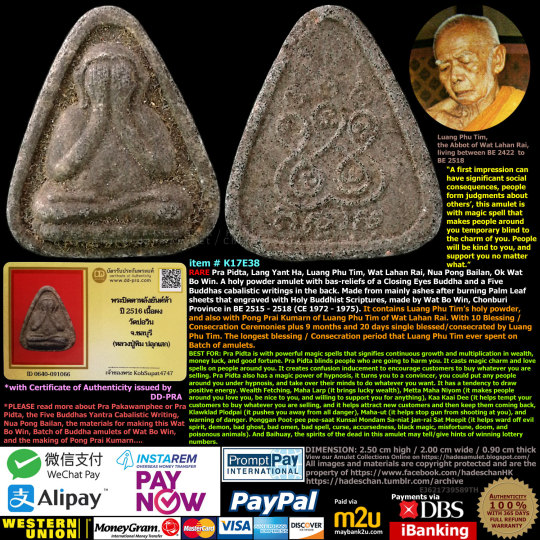
item # K17E38
RARE Pra Pidta, Lang Yant Ha, Luang Phu Tim, Wat Lahan Rai, Nua Pong Bailan, Ok Wat Bo Win. A holy powder amulet with bas-reliefs of a Closing Eyes Buddha and a Five Buddhas cabalistic writings in the back. Made from mainly ashes after burning Palm Leaf sheets that engraved with Holy Buddhist Scriptures, made by Wat Bo Win, Chonburi Province in BE 2515 - 2518 (CE 1972 - 1975). It contains Luang Phu Tim’s holy powder, and also with Pong Prai Kumarn of Luang Phu Tim of Wat Lahan Rai. With 10 Blessing / Consecration Ceremonies plus 9 months and 20 days single blessed/consecrated by Luang Phu Tim. The longest blessing / Consecration period that Luang Phu Tim ever spent on Batch of amulets.
......................................................
“A first impression can have significant social consequences, people form judgments about others’, this amulet is with magic spell that makes people around you temporary blind to the charm of you. People will be kind to you, and support you no matter what.”
......................................................
BEST FOR: Pra Pidta is with powerful magic spells that signifies continuous growth and multiplication in wealth, money luck, and good fortune. Pra Pidta blinds people who are going to harm you. It casts magic charm and love spells on people around you. It creates confusion inducement to encourage customers to buy whatever you are selling. Pra Pidta also has a magic power of hypnosis, it turns you to a convincer, you could put any people around you under hypnosis, and take over their minds to do whatever you want. It has a tendency to draw positive energy. Wealth Fetching, Maha Larp (it brings lucky wealth), Metta Maha Niyom (it makes people around you love you, be nice to you, and willing to support you for anything), Kaa Kaai Dee (it helps tempt your customers to buy whatever you are selling, and it helps attract new customers and then keep them coming back, Klawklad Plodpai (it pushes you away from all danger), Maha-ut (it helps stop gun from shooting at you), and warning of danger. Ponggan Poot-pee pee-saat Kunsai Mondam Sa-niat jan-rai Sat Meepit (it helps ward off evil spirit, demon, bad ghost, bad omen, bad spell, curse, accursedness, black magic, misfortune, doom, and poisonous animals). And Baihuay, the spirits of the dead in this amulet may tell/give hints of winning lottery numbers.
......................................................
Pra Pakawamphee or Pra Pidta (Closing Eyes Buddha)
The Closing Eyes Buddha was an Arhat (one who has gained insight into the true nature of existence and has achieved nirvana), and a disciple of Lord Buddha whose appearance was charming and gorgeously handsome, and people always mistaken him to Buddha and offered him better offerings than other monks, so Pra Pakawamphee turned himself to a fat monk and sealed his face with his 2 hands when he was in his meditation (Pra Pidta / closing eyes Buddha), to blind people around him. So the gesture of Pra Pidta became type of amulet with magical influence to blind people around you with magic charm, and your gaiety and wit would enchanted them all…
......................................................
The Five Buddhas Yantra (Cabalistic Writing), Five Buddhas in Theravada Buddhist Cosmology
The Five Wisdom Buddhas, a group of five “self-born” celestial Buddhas who have always existed from the beginning of time. The five are usually identified as Vairochana, Akshobhya, Ratnasambhava, Amitabha, and Amoghasiddhi. The Five buddhas are a development of the Buddhist Tantras. And they are aspects of the dharmakaya “dharma-body”, which embodies the principle of enlightenment in Buddhism. Each of the “self-born” Buddhas is also said to have manifested himself as an earthly Buddha, an Adi-Buddha (first, or primal, Buddha), and as a Bodhisattva (Buddha-to-be). The Five Buddhas represent:-
1)Vairochana Buddha (Principal deity/meditator), the wisdom of the essence of the dharma-realm meditation mudra.
2)Akshobhya Buddha (East), the wisdom of reflection.
3)Ratnasambhava Buddha (South), the wisdom of equanimity.
4)Amitābha Buddha (West), the wisdom of observation.
5)Amoghasiddhi Buddha (North), the wisdom of perfect practice.
The Power of 5 Buddhas
1.The 5 Buddhas would grant your wish to have glorious future in your career, business, with success plus wealth and prosperity
2.The 5 Buddhas would help bring your good karma from your past life to the present.
3.The 5 Buddhas would help pull you back when you get lost by your choice, and/or by forces beyond your control.
......................................................
Nua Pong Bailan
Nua Pong Bailan is the Buddha amulet that contains mainly ashes after burning Buddhist Palm Leaf Holy Scriptures. Those scriptures were used by monks for studying and praying for sometimes. The process of making holy powder out of them is to set up a bonfire at the special area with auspicious astronomical time. Then monks would sit around the bonfire and pray holy mantras until those scriptures burn into ashes. An amulet made from Pong Bailan is believed to have high power of Metta Maha Niyom (helps bring loving, caring, and kindness, and compassion from people all around you to you).
......................................................
The materials for making this Wat Bo Win Batch of amulets were given by Luang Phu Tim of Wat Laharnrai to Mr.Manord Lao-kwansathid the owner of Navachaihard Store, one of non-monk disciples of Luang Phu Tim to make this Batch in BE 2515-2516 (CE 1972 to CE 1973). The materials (muansarn) are Pong Buddhakhun (all kinds of holy powders), Pong Prai Kumarn, Jeevorn (Luang Phu Tim’s monk robe), hair of the head of Luang Phu Tim, Luang Phu Tim’s pillow (Luang Phu Tim used it since the 1st day he was entering monkshood). Luang Phu Tim said that this is an auspicious object, pillow or Morn in Thai means supporting, it could support fate of the individuals to the best and push up fate of people who are in misfortune to the better.
......................................................
The BE 2515-2516 (BE 1972 - BE 1973) Batch of Buddha amulets of Wat Bo Win, Sriracha, Chonburi Province.
The materials for making this Batch of amulet was given by LP Tim of Wat Laharnrai to Mr.Manord Lao-kwansathid the owner of Navachaihard Store, one of non-monk disciples of LP Tim to make this Batch in BE 2515-2516 (CE 1972 - CE 1973).
The materials (muansarn) are Pong Buddhakhun (all kinds of holy powders), Pong Prai Kumarn, Jeevorn (LP Tim’s monk robe), hair of the head of LP Tim, LP Tim’s pillow (LP Tim used it since the 1st day he was entering monkshood). LP Tim said that this is an auspicious object, pillow or Morn in Thai means supporting, it could support fate of the individuals to the best and push up fate of people who are in misfortune to the better.
After all the amulets were made, there was a Grand Blessing Ceremony at Wat Bo Win in BE 2516 (CE 1973), blessed by:
1.Archan Fand Archaro of Wat Par-udomsomporn
2.Luang Phu Sim of Wat Tam-pah-plong
3.Luang Phu Toh of Wat Pradoochimplee
4.Luang Phu Kaao of Wat Tam-klong-pain
5.Pra Archan Won of Wat Tam-apai-damrongtham
6.Luang Phu Waen Suchinno of Wat Doi Mae-pang
7.Luang Phu Doon of Wat Buraparam
8.Luang Phu Sam of Wat Par-trivivek
After this Blessing Ceremony, this batch of amulets had attained another 9 Blessing / consecration Ceremonies at the temples in Chonburi and Rayong Provinces until mid BE 2517. The last Blessing Ceremony was by Luang Phu Tim alone started from Oct 9, BE 2517 (CE 1974) to July 29, BE 2518 (CE 1975), 9 months and 20days, the longest Blessing that LP Tim EVER did on any Batches of amulets.
......................................................
THE MAKING OF PONG PRAI KUMARN (PONG PRAI KUMARN MAHA PHUUT)
Guru Monks from Thailand who made the best Pong Prai Kumarn are LP Tim of Wat Laharnrai, Rayong Province and LP Tay Kongthong of Wat Sam-ngam Nakorn Pathom Province.
WHAT IS PONG PRAI KUMARN?
It’s a holy powder used for making amulets, and it contains human remains. According to a speech by LP Tim of Wat Laharnrai “obtaining help from power of the Buddha requested by the amulet owners is too slow, but obtaining help from ghosts (spirits) to answer the prayers of the amulet owners is alot faster”.
IS IT BLACK MAGIC? No, it’s not. The Guru monks like LP Tim and LP Tay Kongthong would perform ritual ceremonies to turn / ordain ghosts (spirits) of the dead to “monks”, in Thai called “Buet Phee”. The ghosts (spirits) will not do any harm to the amulet wearers. Those spirits will only do good things and help the amulet wearers for their own merit.
WILL THOSE HOLY SPIRITS LEAVE THE AMULETS? Possibly not. Why?Because each day in spirit world is equal to 100 ordinary solar years of our planet.
WHAT IS ITS POWER?
1) It could make you have a highly activated sixth sense. Sixth sense, or subtle perception ability, is our ability to perceive the subtle-dimension, or the unseen world of angels, ghosts, Heaven (Swarga), etc. It also includes our ability to understand the subtle cause and effect relationship behind many events, which is beyond the understanding of the intellect. Extrasensory perception (ESP), clairvoyance, premonition, intuition are synonymous with sixth sense or subtle perception ability.
2) Maha Larp, it brings lucky wealth.
3) Maha Sanay, it brings magic charms
4) Metta Maha Niyom, it helps you gain loving, kindness and compassion from people all around you.
5) Klaw Klad, Pold Pai, it pushes you away from all danger.
6) Warning of danger
HOW WAS IT MADE?
According to the interview of Mr.Kularp Joichareon (Mor Larp), in BE 2515 (1972) LP Tim had the intention to make Buddha amulets as gifts to people who donated for the construction of Sala Pawwana Pirath Building at Wat Laharnrai, and LP Tim told 2 of his non-monk disciples, Mr.Sai Keawsawang, and Mr.Kularp Joichareon (Mor Larp) that “we will go to get the good stuff tonight, the undertaker will cremate E Som at Wat Laharnrai by tomorrow. And the 2 of you must prepare things for the ritual ceremony”. E Som or Mrs.Som was a pregnant girl, a relative of Mr.Sai Keawsawang`s wife. E Som had a fight with her husband and later committed suicide with 7-8 months pregnancy. E Som died on Saturday and was going to be cremated on Tuesday. After 11 pm that night LP Tim later told Mr.Sai Keawsawang, and Mr.Kularp Joichareon that he would go to bed, and LP Tim said “you have to practise what I have taught you yourself!”, so Mr.Sai Keawsawang, and Mr.Kularp Joichareon had to ride bicycles to the grave yard of Wat Laharnyai where the body of E Som was buried, by themselves. Soon after arriving at the grave of E Som, Mr.Sai Keawsawang, and Mr.Kularp Joichareon did the ritual ceremony to ask permission from the Master of the Grave yard, and then asked E Som to give the skull of her unborn child, and some oil from her flesh (Namman Prai) around her abdominal area.
The next day (Tuesday) before the cremation of E Som`s body at Wat Laharnrai, Mr.Sai Keawsawang, and Mr.Kularp Joichareon told the undertaker not to burn her body to ashes. Before cremation, Mr.Sai Keawsawang drilled a hole in the ground of cremation site under the position E Som’s body would be placed, and put an empty iron can to capture body fat of E Som while being burnt. After cremation, in the night, when everybody had left, Mr.Sai Keawsawang, and Mr.Kularp Joichareon went to the cremation site with one kettle of holy water given by LP Tim. Mr.Sai Keawsawang, and Mr.Kularp Joichareon collected the skull of E Som’s unborn child, a rib bone from E Som’s womb area, E Som`s skull, and the iron can that contained Namman Prai.
After getting what they wanted Mr.Sai Keawsawang, and Mr.Kularp Joichareon threw holy water from the kettle from their heads to their toes, to wash away bad omens that would come with the stuff they were taking from the cremation site. Mr.Sai Keawsawang, and Mr.Kularp Joichareon gave the stuff to LP Tim, and LP Tim performed a ritual ceremony in his monk-house alone, non-stop for 3 days and 3 nights without food, drink (LP Tim was a vegetarian), or sleep. After LP Tim’s ritual ceremony, LP Tim gave the 2 skulls and bone to Mr.Kularp Joichareon to grind them into powder by stone mortar. Soon after the grounding had finished, that stone mortar magically broke into 2 pieces.
Mr.Kularp Joichareon could grind those bone and skulls into an amount of fine powder that would fit inside 1 can of Mali Sweetened Condensed Milk 397 ml. Mr.Kularp Joichareon also had to grind 108 kinds of sacred, sun dried herbs, along with a large amount of fertilizer they had previously dried out, then mixed it all with the bone powder. Mr.Kularp Joichareon`s mixture was equivalent to about 1 jar (7200 ml). This was later mixed with Holy Powder`s made by LP Tim including Pong Pattamang, Pong Ittijay and Pong Tri Nisinghe. The total quantity of finished Pong Prai Kumarn was equivalent to about 3 quarters of an iron bucket (16 litres).
TRANSLATION BY HADES CHAN
PROOF READ BY CHRIS KIDD
......................................................
*This amulet contains human remains. Not suitable for people who have Spectrophobia (the fear of ghosts). People who have Spectrophobia cannot control themselves while experiencing ghosts, they might have sudden cardiac death or cause harm to themselves from temporary loss of consciousness.
......................................................
*with Certificate of Authenticity issued by DD-PRA
......................................................
DIMENSION: 2.50 cm high / 2.00 cm wide / 0.90 cm thick
......................................................
item # K17E38
Price: price upon request, pls PM and/or email us [email protected]
100% GENUINE WITH 365 DAYS AUTHENTICITY GUARANTEE.
Item location: Hong Kong, SAR
Ships to: Worldwide
Delivery: Estimated 7 days handling time after receipt of cleared payment. Please allow additional time if international delivery is subject to customs processing.
Shipping: FREE Thailandpost International registered mail. International items may be subject to customs processing and additional charges.
Payments: PayPal / Western Union / MoneyGram /maybank2u.com / DBS iBanking / Alipay / Wechat Pay / PromptPay International / Remitly / PAYNOW
**************************************
0 notes
Text
THE 150 GREATEST (FORMAL & INFORMAL) PERSONALITIES IN THE KNOWN HISTORY/COLLECTIVE CONSCIOUSNESS OF INDIA !
(THE FREE-FOR-ALL LIST, NOT RESTRICTED TO PADMA AWARDEES OR STAMP HOLDERS, EVEN IF INCL A MAJORITY OF THEM )
Ie. THE 150 GREATEST PEOPLE IN INDIAN HISTORY !
Rajesh Khanna
C.V. Raman
Online Indie
Jayaprakash Narayan
J.R.D. Tata
Subhash Chandra Bose
Swami Vivekananda
Lal Bahadur Shastri
Srinivasa Ramanujam
Bhagwan Sri Sathya Sai Baba
Valmiki
Bhagwan Shri Shirdi Sai Baba
Ramakrishna Paramhansa
Bhagwan Shiva
Bhagwan Ganesha
Mata Parvati / Amma Karunamayi
Bhagwan Krishna
Bhagwan Ram
Bhagwan Mahavira
Maharana Pratap
Jagadish Chandra Bose
Major Dhyan Chand
Govind Ballabh Pant
Lala Lajpat Rai
Dhirubhai Ambani
Meena Kumari
Mother Teresa
Chhatrapati Shivaji
Bal Gangadhar Kher
Madan Mohan Malviya
Kishore Kumar
Dr. Sarvapalli Radhakrishnan
Dr. Bhagwan Das
Guru Nanak
Allama Mashriqi
Lokmanya Tilak
Tansen
Lord Hanuman
Vithalbhai Patel
Atal Behari Vajpayee
P.U.M. Thevar
Nandlal Bose
Rabindranath Tagore
Dr. Babasaheb Ambedkar
Prem Chand
Jesus Christ
Adi Shankaracharya
K. L. Saigal
N. T. Ramarao
Dr. Devi Prasad Shetty
B. R. Chopra
Viswanathan Anand
Sri Aurobindo
Rani Laxmibai
Chakravarti Rajagopalachari
Narendra Modi
Milkha Singh
Mirza Ghalib
Dr. K.S. Krishnan
Dr. Satyendra Nath Bose
Dr. Zakir Hussain
Dr. M. Visvesvaraiya
Satyajit Ray
Bankim Chandra Chatterjee
Ramana Maharishi
Radha (Ancient Krishna devotee)
Chandulal Madhavlal Trivedi
Mahatma Jyotirao Phule
Savitribai Phule
Lt. Col. Maharaj Kumar Namgyal
Shammi Kapoor
Indira Gandhi
Dev Anand
Jijabai
Sadhu Vaswani
Raja Ravi Varma
Saiyid Fazl Ali
Ashok Kumar
Dr. Madhav Shrihari Aney
Gopal Das Neeraj
Ajudhia Nath Khosla
Shashi Kapoor
Ustad Bade Ghulam Ali Khan
Dr. Arcot Lakshmanaswami Mudaliar
Bipin Chandra Pal
Dr. Jnan Chandra Ghosh
Paramhansa Yogananda
Thiruvallavur
Buddha
Maharishi Patanjali
Dr. Nambi Narayanan
Dr. Verghese Kurien
Dadasaheb Phalke
Arjun (of Gita)
Waheeda Rehman
Dr. P.V. Kane
Jigme Dorji Wangchuk
Veer Savarkar
Thakkar Bapa
Ahilyabai Holkar
Rash Behari Bose
Sane Guruji
Maharishi Mahesh Yogi
Swami Ranganathananda
Dr. Shanti Swarup Bhatnagar
M. S. Subbalakshmi
Dr. Satish Dhawan
Chaitanya Mahaprabhu
Surdas
A. Ramaswamy Mudaliar
Mohandas Karamchand Gandhi
Prafulla Chandra Roy
Kabir (pre-independence poet)
Zubin Mehta
Kalidasa
Suchitra Sen
Tyagaraja
M. G. Ramachandran
Dr. Prabha Atre (classical singer)
Kavi Pradeep
Pt. Kishan Maharaj (tabla)
R.K. Laxman
Mirabai
Tulsidas
Uttam Kumar
Dr. K. Kasturirangan
Ashfaqullah Khan
Dr. Dhondo Keshav Karve
Ram Prasad Bismil
Chandrashekhar Azad
Tenzing Norgay
N.R. Narayana Murthy
Kumaran Asan
Bhai Vir Singh
Dr. Shyama Prasad Mukherjee
Dr. John Matthai
Subramanya Bharati
Pt. Omkarnath Thakur
Emperor Indravarman (of Srivijaya Empire (7th c – 12th c))
Vaidyaraj Sushil Kumar Jain (Jaipur, present day)
Sant Tukaram
Emperor Lalitaditya Muktapida (of Karakota Empire(7th c–9thc))
Peshwa Balaji Vishwanath (Maratha Empire)
Emperor Akbar (Mughal Empire)
Laxmikant-Pyarelal
R.D. Burman
Shankar-Jaikishan
S. D. Burman
Manoj Kumar
Mohammad Rafi .





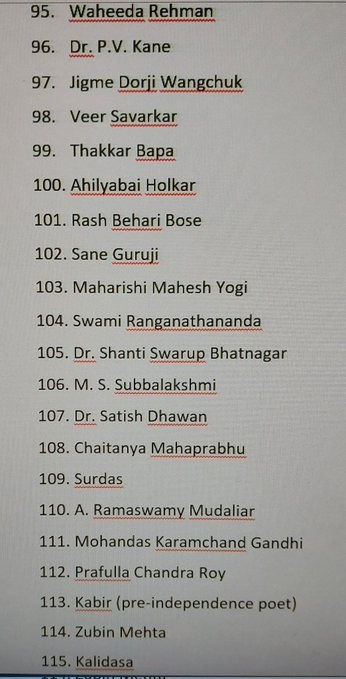



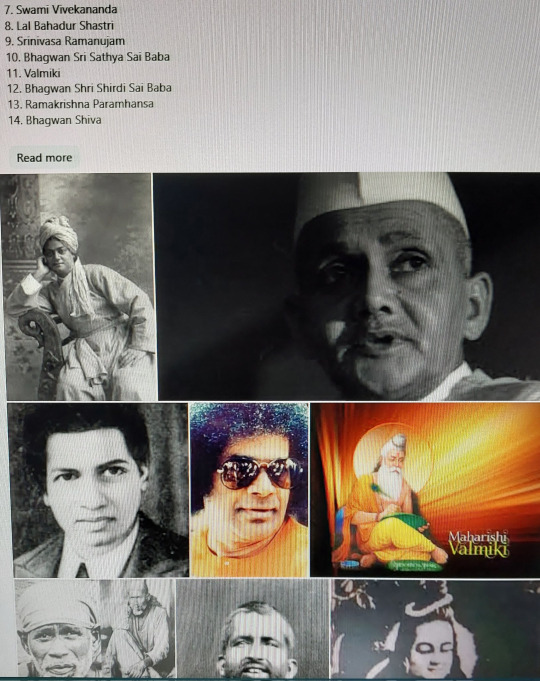
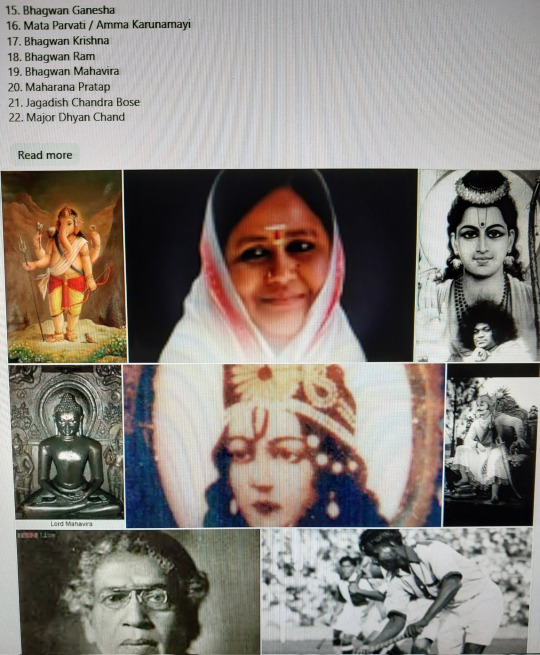



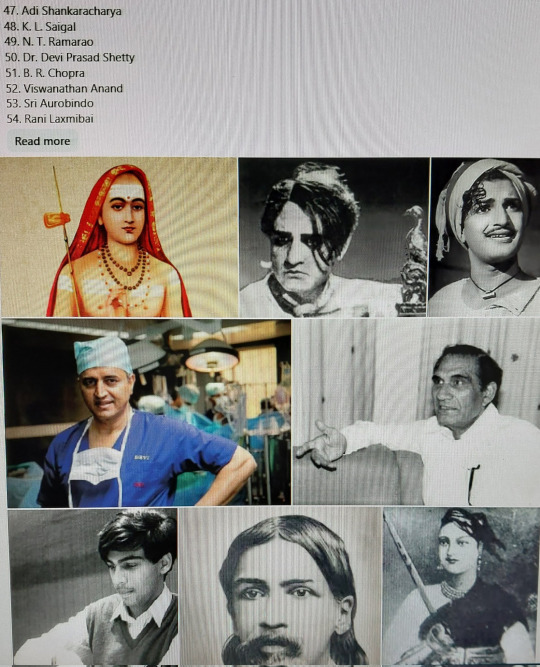




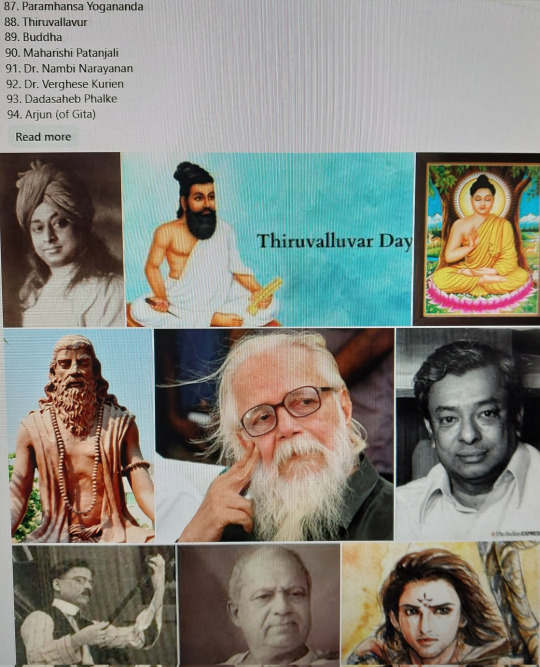



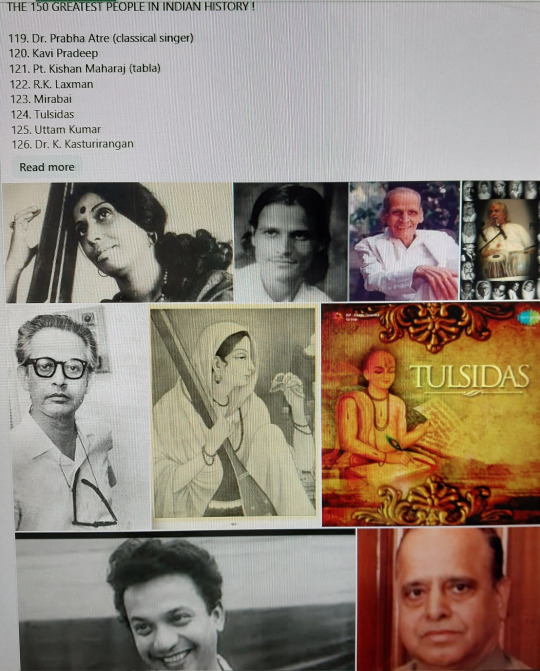
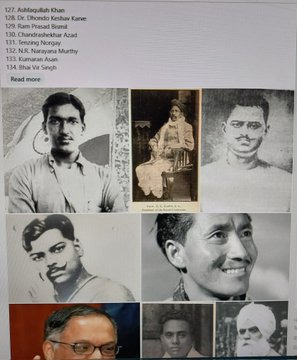
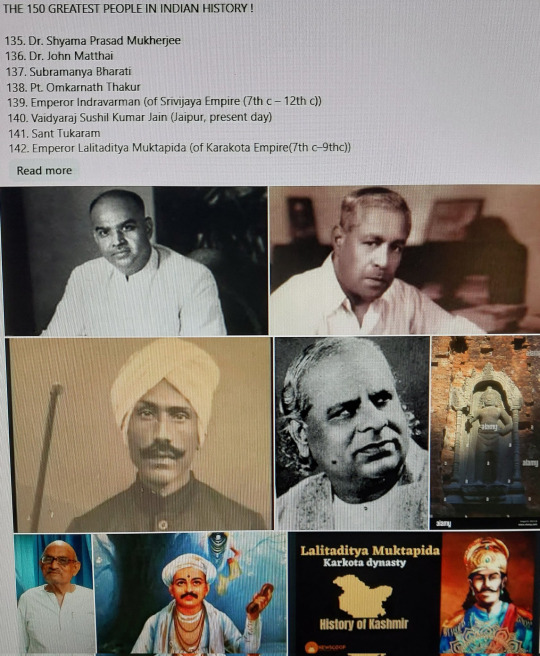

1 note
·
View note
Text
List of my metas (One Piece and others)
One Piece
Doflamingo
1: Donquixote Doflamingo’s reasons and motivation
2: It’s hard to believe just how much Doflamingo loved his father
3: What I meant when I said Doflamingo had no choice but to kill his father
4: The Dressrosa Arc is interesting to say the least (about how Doflamingo is Shinji to Law’s Bardiel-infested Eva-03)
5: Donquixote Doflamingo and the clan of D
6: Doflamingo knows the WG’s biggest secret, so they hunt him
7: Smiling and freedom
8: It's funny to see the difference in how Trebol and Doflamingo try to talk Law out of fighting
9: How to become a member of the Donquixote Family (and how better not to even try)
10: Aku no charisma
11: The worst card
12: Interesting things about the Luffy vs. Doffy fight
13: Corazon's scars and possibility that Doflamingo has the same
14: Why Doflamingo is my favorite character
15: Another difference between anime and manga (about important details in Doflamingo’s relationship with his family)
Bits & pieces: 1) Flamingos are tough as hell, 2) A great frame from chapter 763: Doflamingo tries to attack the lynch mob, but his father holds him, 3) The Donquixote Family supper and The Last Supper, 4) It struck me that Vergo was the only person in the manga to show compassion for Doflamingo, 5) When Doflamingo defeated Law and took him to the palace, he took his sword as well, 6) Aren't the Marines supposed to protect the common people?, 7) Aren't there too many bottles, huh?, 8) We all live in a society
Monet
The Snow Woman of the Biscuits Room
Lao G
Quite possible it was Lao G who was supposed to perform the immortality operation, since he was the best candidate
Kaidou & Yamato
Bits & pieces: 1) Kaidou has a very sad understanding of the world and relationships, 2) Yamato was such a stubborn child it’s incomprehensible, 3) Ōeyama no Tsuki makes the Wano Country Arc much funnier, 4) It sure must be hard when your father is Atilla, King of the Huns, but it’s strange to expect him not to follow through on his threat when you have no intention of sparing his life
King
Looks like King's been wearing the same haircut his entire life
Lunarians and Ishvalans
~~~
In Rebecca's flashback, there are three seats at the dinner table
Chapter 1049
The sad tale of the Kurozumi Family
Chapter 1060
Kurozumis continued to be hunted even after 40 years
Is Im the Adi-Buddha, and are the Five Elders the lords of the Five Buddha Families?
The Drum Kingdom citizens didn’t wish harm on Hiriluk even after all the shit he had done to them (he should have been in the Wano Country)
Chapter 1085
Chapter 1086
What I think about Dr. Hiriluk
10 theories about Im-sama‘s name (a translation)
Satan Saturn
Chainsaw Man
Pro-Makima agenda: 1, 2, 3
Nayuta seems very mature for her age
Kung Fu Panda
The truth about Tai Lung (a translation)
Star Wars
On the essence of the Galactic Civil War (a translation)
How should we rebuild the Galaxy? (a translation)
Wolfsmund
Man in wolf’s skin
The unexpected side of Gestapo-kun
Berserk
Griffith’s way of thinking
Kaiji
NGE references in Kaiji
Barbie (2023)
Prequel to a movie about Ken (a translation)
Akame ga Kill!
Esdeath’s daddy issues
#one piece#Op meta#one piece meta#chainsaw man#kung fu panda#star wars#wolfsmund#berserk#kaiji#barbie 2023#akame ga kill
17 notes
·
View notes
